Species Classification and Carbon Stock Assessment of Mangroves in Qi’ao Island with Worldview-3 Imagery
Abstract
1. Introduction
2. Study Area and Data Materials
2.1. Study Area
2.2. Satellite Data and Pre-Processing
2.3. Field Data
2.4. Mangrove Carbon-Density Data
3. Methods
3.1. Selection of Samples
3.2. Extraction of the Features
3.2.1. Index Features
3.2.2. Derivation Features
3.2.3. Textural Features
3.2.4. Features Combinations
3.3. Random Forest Classifier
3.4. Accuracy Assessment
3.5. Mangrove Carbon-Stock Assessment
4. Results and Analysis
4.1. Accuracy Assessment of the Mangrove-Species Classification
4.2. Spatial Distribution of Mangrove Species
4.3. Area and Carbon Stock Assessment
5. Discussion
6. Conclusions
Supplementary Materials
Author Contributions
Funding
Data Availability Statement
Acknowledgments
Conflicts of Interest
Abbreviations
| AI | Acanthus ilicifolius |
| AA | Acrostichum aureum |
| AC | Aegiceras corniculatum |
| HL | Heritiera littoralis |
| KC | Kandelia candel |
| Kappa | kappa coefficient |
| LCD | litter carbon density |
| OA | overall accuracy |
| PA | producer’s accuracy |
| RE | reeds |
| SCD | soil carbon density |
| SA | Sonneratia apetala |
| SA2 | Sporobolus alterniflorus |
| TCD | total carbon density |
| TCS | total carbon stock |
| UA | user’s accuracy |
| VCD | vegetation carbon density |
References
- Giri, C.; Ochieng, E.; Tieszen, L.L.; Zhu, Z.; Singh, A.; Loveland, T.; Masek, J.; Duke, N. Status and distribution of mangrove forests of the world using earth observation satellite data. Glob. Ecol. Biogeogr. 2011, 20, 154–159. [Google Scholar] [CrossRef]
- Borges, A.V.; Djenidi, S.; Lacroix, G.; Théate, J.; Delille, B.; Frankignoulle, M. Atmospheric CO2 flux from mangrove surrounding waters. Geophys. Res. Lett. 2003, 30, 1558. [Google Scholar] [CrossRef]
- Wong, W.Y.; Al-Ani, A.K.I.; Hasikin, K.; Khairuddin, A.S.M.; Razak, S.A.; Hizaddin, H.F.; Mokhtar, M.I.; Azizan, M.M. Water, Soil and Air Pollutants’ Interaction on Mangrove Ecosystem and Corresponding Artificial Intelligence Techniques Used in Decision Support Systems—A Review. IEEE Access 2021, 9, 105532–105563. [Google Scholar] [CrossRef]
- Tateda, Y.; Upstill Goddard, R.C.; Goreau, T.J.F.; Alongi, D.M.; Nose, A.; Kristensen, E.; Wattayakorn, G. Greenhouse Gas and Carbon Balances in Mangrove Coastal Ecosystems; Maruzen Publishing: Tokyo, Japan, 2007. [Google Scholar]
- Wan, L.; Zhang, H.; Wang, T.; Li, G.; Lin, H. Mangrove Species Discrimination from Very High Resolution Imagery Using Gaussian Markov Random Field Model. Wetlands 2018, 38, 861–874. [Google Scholar] [CrossRef]
- Harty, C. Planning Strategies for Mangrove and Saltmarsh Changes in Southeast Australia. Coast. Manag. 2004, 32, 405–415. [Google Scholar] [CrossRef]
- Gandhi, S.; Jones, T. Identifying Mangrove Deforestation Hotspots in South Asia, Southeast Asia and Asia-Pacific. Remote Sens. 2019, 11, 728. [Google Scholar] [CrossRef]
- Hidayatullah, M.F.; Kamal, M.; Wicaksono, P. Species-based aboveground mangrove carbon stock estimation using WorldView-2 image data. Remote Sens. Appl. Soc. Environ. 2023, 30, 100959. [Google Scholar] [CrossRef]
- Quevedo, J.M.D.; Uchiyama, Y.; Kohsaka, R. Perceptions of local communities on mangrove forests, their services and management: Implications for Eco-DRR and blue carbon management for Eastern Samar, Philippines. J. For. Res. 2020, 25, 1–11. [Google Scholar] [CrossRef]
- Ramdani, F.; Rahman, S.; Giri, C. Principal polar spectral indices for mapping mangroves forest in South East Asia: Study case Indonesia. Int. J. Digit. Earth 2019, 12, 1103–1117. [Google Scholar] [CrossRef]
- Mohammad Abdullah, A.N.; Stacey, N.; Garnett, S.T.; Myers, B. Economic dependence on mangrove forest resources for livelihoods in the Sundarbans, Bangladesh. For. Policy Econ. 2016, 64, 15–24. [Google Scholar] [CrossRef]
- Rajakumari, S.; Rajaram, P. Sustainability assessment for coexistence of afforested mangroves and aquafarms upon existing and predicted scenarios: A case study in Southern Tamil Nadu coast. Environ. Dev. Sustain. 2021, 23, 4751–4763. [Google Scholar] [CrossRef]
- Sachin, S.M.; Yadav, V.K.; Pal, S.; Karmakar, S.; Bharti, V.S. Survey based economic evaluation of ecosystem services of mangrove from Uttar Kannada district of Karnataka, India. J. Environ. Biol. 2020, 41, 980–986. [Google Scholar] [CrossRef]
- Jia, M.; Wang, Z.; Mao, D.; Huang, C.; Lu, C. Spatial-temporal changes of China’s mangrove forests over the past 50 years: An analysis towards the Sustainable Development Goals (SDGs). Chin. Sci. Bull. 2021, 66, 3886–3901. [Google Scholar] [CrossRef]
- Jupiter, S.D.; Potts, D.C.; Phinn, S.R.; Duke, N.C. Natural and anthropogenic changes to mangrove distributions in the Pioneer River Estuary (QLD, Australia). Wetl. Ecol. Manag. 2007, 15, 51–62. [Google Scholar] [CrossRef][Green Version]
- Lu, C.; Li, L.; Wang, Z.; Su, Y.; Su, Y.; Huang, Y.; Jia, M.; Mao, D. The national nature reserves in China: Are they effective in conserving mangroves? Ecol. Indic. 2022, 142, 109265. [Google Scholar] [CrossRef]
- Adame, M.F.; Connolly, R.M.; Turschwell, M.P.; Lovelock, C.E.; Fatoyinbo, T.; Lagomasino, D.; Goldberg, L.A.; Holdorf, J.; Friess, D.A.; Sasmito, S.D.; et al. Future carbon emissions from global mangrove forest loss. Glob. Change Biol. 2021, 27, 2856–2866. [Google Scholar] [CrossRef]
- Ouyang, X.; Lee, S.Y. Improved estimates on global carbon stock and carbon pools in tidal wetlands. Nat. Commun. 2020, 11, 317. [Google Scholar] [CrossRef]
- Shen, X.; Li, R.; Chai, M.; Cheng, S.; Niu, Z.; Qiu, G.Y. Interactive effects of single, binary and trinary trace metals (lead, zinc and copper) on the physiological responses of Kandelia obovata seedlings. Environ. Geochem. Health 2019, 41, 135–148. [Google Scholar] [CrossRef]
- Schaffelke, B.; Mellors, J.; Duke, N.C. Water quality in the Great Barrier Reef region: Responses of mangrove, seagrass and macroalgal communities. Mar. Pollut. Bull. 2005, 51, 279–296. [Google Scholar] [CrossRef]
- Cerón, R.M.; Cerón, J.G.; Guerra, J.J.; López, E.T.; Endañu, E.; Ramírez, M.B.; García, M.; Sánchez, R.A.G.; Mendoza, S.J.V. Effects of simulated Acid Rain on Tropical trees of the coastal zone of Campeche, Mexico. In Coastal Processes; WIT Press: Southampton, UK, 2009. [Google Scholar]
- Griselda, C.; Cerón-Bretón, R.; Aguilar-Ucan, J. Ozone-Exposure responses of three Mangrove species by using open top chambers. In Energy and Environmental Engineering; World Scientific and Engineering Academy and Society: Athens, Greece, 2009. [Google Scholar]
- Hoshika, Y.; Tatsuda, S.; Watanabe, M.; Wang, X.; Watanabe, Y.; Saito, H.; Koike, T. Effect of ambient ozone at the somma of Lake Mashu on growth and leaf gas exchange in Betula ermanii and Betula platyphylla var. japonica. Environ. Exp. Bot. 2013, 90, 12–16. [Google Scholar] [CrossRef]
- Zapletal, M.; Juran, S.; Krpes, V.; Michna, K.; Cudlin, P.; Edwards, M. Effect of ozone flux on selected structural and antioxidant characteristics of a mountain Norway spruce forest. Balt. For. 2018, 24, 261–267. [Google Scholar]
- Kelleway, J.J.; Saintilan, N.; Macreadie, P.I.; Baldock, J.A.; Heijnis, H.; Zawadzki, A.; Gadd, P.; Jacobsen, G.; Ralph, P.J. Geochemical analyses reveal the importance of environmental history for blue carbon sequestration. J. Geophys. Res. Biogeosci. 2017, 122, 1789–1805. [Google Scholar] [CrossRef]
- Trégarot, E.; Caillaud, A.; Cornet, C.C.; Taureau, F.; Catry, T.; Cragg, S.M.; Failler, P. Mangrove ecological services at the forefront of coastal change in the French overseas territories. Sci. Total Environ. 2021, 763, 143004. [Google Scholar] [CrossRef] [PubMed]
- Candra, E.D.; Hartono; Wicaksono, P. Above Ground Carbon Stock Estimates of Mangrove Forest Using Worldview-2 Imagery in Teluk Benoa, Bali. IOP Conf. Ser. Earth Environ. Sci. 2016, 47, 12014. [Google Scholar] [CrossRef]
- Meng, Y.; Bai, J.; Gou, R.; Cui, X.; Feng, J.; Dai, Z.; Diao, X.; Zhu, X.; Lin, G. Relationships between above- and below-ground carbon stocks in mangrove forests facilitate better estimation of total mangrove blue carbon. Carbon Balance Manag. 2021, 16, 8. [Google Scholar] [CrossRef] [PubMed]
- Meng, Y.; Gou, R.; Bai, J.; Moreno Mateos, D.; Davis, C.C.; Wan, L.; Song, S.; Zhang, H.; Zhu, X.; Lin, G. Spatial patterns and driving factors of carbon stocks in mangrove forests on Hainan Island, China. Glob. Ecol. Biogeogr. 2022, 31, 1692–1706. [Google Scholar] [CrossRef]
- Jiang, Y.; Zhang, L.; Yan, M.; Qi, J.; Fu, T.; Fan, S.; Chen, B. High-Resolution Mangrove Forests Classification with Machine Learning Using Worldview and UAV Hyperspectral Data. Remote Sens. 2021, 13, 1529. [Google Scholar] [CrossRef]
- Polychronaki, A.; Gitas, I.Z. Burned Area Mapping in Greece Using SPOT-4 HRVIR Images and Object-Based Image Analysis. Remote Sens. 2012, 4, 424–438. [Google Scholar] [CrossRef]
- Jia, M.; Wang, Z.; Li, L.; Song, K.; Ren, C.; Liu, B.; Mao, D. Mapping China’s mangroves based on an object-oriented classification of Landsat imagery. Wetlands 2014, 34, 277–283. [Google Scholar] [CrossRef]
- Blanco-Sacrist, N.J.; Johansen, K.; Duarte, C.M.; Daffonchio, D.; Hoteit, I.; McCabe, M.F. Mangrove distribution and afforestation potential in the Red Sea. Sci. Total Environ. 2022, 843, 157098. [Google Scholar] [CrossRef]
- Wang, D.; Wan, B.; Qiu, P.; Su, Y.; Guo, Q.; Wu, X. Artificial Mangrove Species Mapping Using Pléiades-1: An Evaluation of Pixel-Based and Object-Based Classifications with Selected Machine Learning Algorithms. Remote Sens. 2018, 10, 294. [Google Scholar] [CrossRef]
- Rahmandhana, A.D.; Kamal, M.; Wicaksono, P. Spectral Reflectance-Based Mangrove Species Mapping from WorldView-2 Imagery of Karimunjawa and Kemujan Island, Central Java Province, Indonesia. Remote Sens. 2022, 14, 183. [Google Scholar] [CrossRef]
- Li, Y.; Zuo, X.; Li, H. Classification of Mangrove Population Based on WorldView-2—A Case Study of Shenzhen Bay. Comput. Eng. Softw. 2020, 41, 134–138. [Google Scholar]
- Peng, L.; Liu, K.; Cao, J.; Zhu, Y.; Li, F.; Liu, L. Combining GF-2 and RapidEye satellite data for mapping mangrove species using ensemble machine-learning methods. Int. J. Remote Sens. 2020, 41, 813–838. [Google Scholar] [CrossRef]
- Rahman, M.M.; Lagomasino, D.; Lee, S.; Fatoyinbo, T.; Ahmed, I.; Kanzaki, M. Improved assessment of mangrove forests in Sundarbans East Wildlife Sanctuary using WorldView 2 and TanDEM-X high resolution imagery. Remote Sens. Ecol. Conserv. 2019, 5, 136–149. [Google Scholar] [CrossRef]
- Zhu, Y.; Liu, K.; Liu, L.; Myint, S.W.; Wang, S.; Cao, J.; Wu, Z. Estimating and Mapping Mangrove Biomass Dynamic Change Using WorldView-2 Images and Digital Surface Models. IEEE J. Sel. Top. Appl. Earth Obs. Remote Sens. 2020, 13, 2123–2134. [Google Scholar] [CrossRef]
- Islam, M.K.; Simic Milas, A.; Abeysinghe, T.; Tian, Q. Integrating UAV-Derived Information and WorldView-3 Imagery for Mapping Wetland Plants in the Old Woman Creek Estuary, USA. Remote Sens. 2023, 15, 1090. [Google Scholar] [CrossRef]
- Liu, H.; Ren, H.; Hui, D.; Wang, W.; Liao, B.; Cao, Q. Carbon stocks and potential carbon storage in the mangrove forests of China. J. Environ. Manag. 2014, 133, 86–93. [Google Scholar] [CrossRef]
- Qiu, N.; Xu, S.; Qiu, P.; Yang, W.; Yang, X.; Yang, Q. Community Distribution and Landscape Pattern of the Mangrove on the Qi’ao Island, Zhuhai. Sci. Silvae Sin. 2019, 55, 1–10. [Google Scholar]
- Wang, Z.; Chen, W.; Guan, W.; Liao, B.; He, K.; Chen, W.; Xie, M. Study on Zhuhai Qi’ao island main mangrove community characteristics. J. Cent. South Univ. For. Technol. 2017, 37, 86–91. [Google Scholar]
- Kruse, F.A.; Perry, S.L. Mineral Mapping Using Simulated Worldview-3 Short-Wave-Infrared Imagery. Remote Sens. 2013, 5, 2688–2703. [Google Scholar] [CrossRef]
- Hu, Y.; Zhu, N.; Hao, B.; You, Y.; Tang, H. Carbon density and carbon fixation rate of mangroves of different restoration types in Qi’ao island. J. Cent. South Univ. For. Technol. 2019, 39, 101–107. [Google Scholar]
- McFeeters, S.K. The use of the Normalized Difference Water Index (NDWI) in the delineation of open water features. Int. J. Remote Sens. 1996, 17, 1425–1432. [Google Scholar] [CrossRef]
- Haralick, R.M.; Shanmugam, K.; Dinstein, I.H. Textural Features for Image Classification. IEEE Trans. Syst. Man Cybern. 1973, SMC-3, 610–621. [Google Scholar] [CrossRef]
- Huete, A.; Didan, K.; Miura, T.; Rodriguez, E.P.; Gao, X.; Ferreira, L.G. Overview of the radiometric and biophysical performance of the MODIS vegetation indices. Remote Sens. Environ. 2002, 83, 195–213. [Google Scholar] [CrossRef]
- Tucker, C.J. Red and photographic infrared linear combinations for monitoring vegetation. Remote Sens. Environ. 1979, 8, 127–150. [Google Scholar] [CrossRef]
- Wang, T.; Zhang, H.; Lin, H.; Fang, C. Textural–Spectral Feature-Based Species Classification of Mangroves in Mai Po Nature Reserve from Worldview-3 Imagery. Remote Sens. 2016, 8, 24. [Google Scholar] [CrossRef]
- Jensen, J.R. Introductory Digital Image Processing: A Remote Sensing Perspective. In Geocarto International; Pearson Education: Upper Saddle River, NJ, USA, 2005. [Google Scholar]
- Li, F. Leaf Nitrogen Content Estimation of Winter Wheat Based on Hyper-Spectral and Satellite Imagery Data in Guanzhong Region; Northwest A&F University: Xianyang, China, 2016. [Google Scholar]
- Huang, X.; Zhang, L.; Wang, L. Evaluation of Morphological Texture Features for Mangrove Forest Mapping and Species Discrimination Using Multispectral IKONOS Imagery. IEEE Geosci. Remote Sens. Lett. 2009, 6, 393–397. [Google Scholar] [CrossRef]
- Rao, C.N.; Sastry, S.S.; Mallika, K. Co-Occurrence Matrix and Its Statistical Features as an Approach for Identification of Phase Transitions of Mesogens. Int. J. Innov. Res. Sci. Eng. Technol. 2013, 2, 4531–4538. [Google Scholar]
- Cao, J.; Liu, K.; Zhu, Y.; Li, J.; He, Z. Identifying Mangrove Species Using Field Close-Range Snapshot Hyperspectral Imaging and Machine-Learning Techniques. Remote Sens. 2018, 10, 2047. [Google Scholar] [CrossRef]
- Milosevic, M.; Jankovic, D.; Peulic, A. Thermography based breast cancer detection using texture features and minimum variance quantization. EXCLI J. 2014, 13, 1204–1215. [Google Scholar] [PubMed]
- Alharan, A.; Fatlawi, H.; Ali, N. A cluster-based feature selection method for image texture classification. Indones. J. Electr. Eng. Comput. Sci. 2019, 14, 1433–1442. [Google Scholar] [CrossRef]
- Feng, J.; Yang, Y. Study of Texture Images Extraction Based on Gray Level Co-Occurence Matrix. Beijing Surv. Map. 2007, 3, 19–22. [Google Scholar]
- Breiman, L. Random Forests. Mach. Learn. 2001, 45, 5–32. [Google Scholar] [CrossRef]
- Gilani, H.; Naz, H.I.; Arshad, M.; Nazim, K.; Akram, U.; Abrar, A.; Asif, M. Evaluating mangrove conservation and sustainability through spatiotemporal (1990–2020) mangrove cover change analysis in Pakistan. Estuar. Coast. Shelf Sci. 2021, 249, 107128. [Google Scholar] [CrossRef]
- Pal, M. Random forest classifier for remote sensing classification. Int. J. Remote Sens. 2005, 26, 217–222. [Google Scholar] [CrossRef]
- Li, X.; Liu, K.; Zhu, Y.; Meng, L.; Yu, C.; Cao, J. Study on Mangrove Species Classification based on ZY-3 Image. Remote Sens. Technol. Appl. 2018, 33, 360–369. [Google Scholar]
- Li, Q.; Wong, F.K.K.; Fung, T. Classification of Mangrove Species Using Combined WordView-3 and LiDAR Data in Mai Po Nature Reserve, Hong Kong. Remote Sens. 2019, 11, 2114. [Google Scholar] [CrossRef]
- Sun, X.; Huang, Z.; Zhang, Q.; Wen, Q.; Huang, Z.; Wang, C.; Zhang, R.; Xu, S. The Biological Carbon Storage Change of Artificial Secondary Sonneratia apetala on Qi’ao Island, Zhuhai. J. South China Norm. Univ. Nat. Sci. Ed. 2022, 54, 89–100. [Google Scholar]
- Miraki, M.; Sohrabi, H.; Immitzer, M. Tree Species Mapping in Mangrove Ecosystems Using UAV-RGB Imagery and Object-Based Image Classification. J. Indian Soc. Remote Sens. 2023, 51, 2095–2103. [Google Scholar] [CrossRef]
- Oldeland, J.; Revermann, R.; Luther-Mosebach, J.; Buttschardt, T.; Lehmann, J.R.K. New tools for old problems—Comparing drone- and field-based assessments of a problematic plant species. Environ. Monit. Assess. 2021, 193, 90. [Google Scholar] [CrossRef] [PubMed]
- Feng, Q.; Liu, J.; Gong, J. UAV Remote Sensing for Urban Vegetation Mapping Using Random Forest and Texture Analysis. Remote Sens. 2015, 7, 1074–1094. [Google Scholar] [CrossRef]
- Pham, M.; Mercier, G.; Regniers, O.; Michel, J. Texture Retrieval from VHR Optical Remote Sensed Images Using the Local Extrema Descriptor with Application to Vineyard Parcel Detection. Remote Sens. 2016, 8, 368. [Google Scholar] [CrossRef]
- Kwak, G.; Park, N. Impact of Texture Information on Crop Classification with Machine Learning and UAV Images. Appl. Sci. 2019, 9, 643. [Google Scholar] [CrossRef]
- Bradley, B.A. Remote detection of invasive plants: A review of spectral, textural and phenological approaches. Biol. Invasions 2014, 16, 1411–1425. [Google Scholar] [CrossRef]
- Lantz, N.J.; Wang, J. Object-based classification of Worldview-2 imagery for mapping invasive common reed, Phragmites australis. Can. J. Remote Sens. 2013, 39, 328–340. [Google Scholar] [CrossRef]
- Cao, J.; Liu, K.; Zhuo, L.; Liu, L.; Zhu, Y.; Peng, L. Combining UAV-based hyperspectral and LiDAR data for mangrove species classification using the rotation forest algorithm. Int. J. Appl. Earth Obs. Geoinf. 2021, 102, 102414. [Google Scholar] [CrossRef]
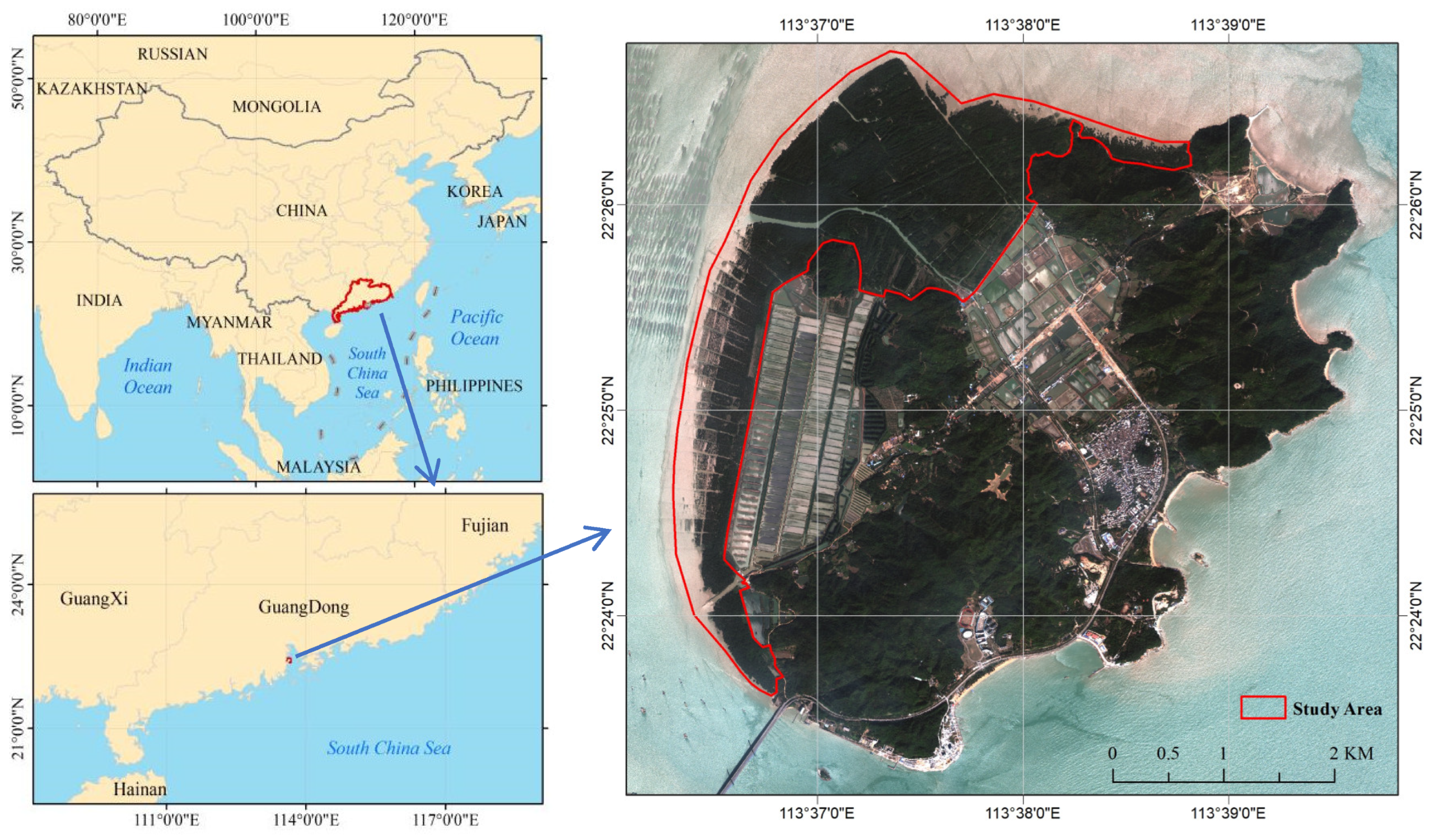

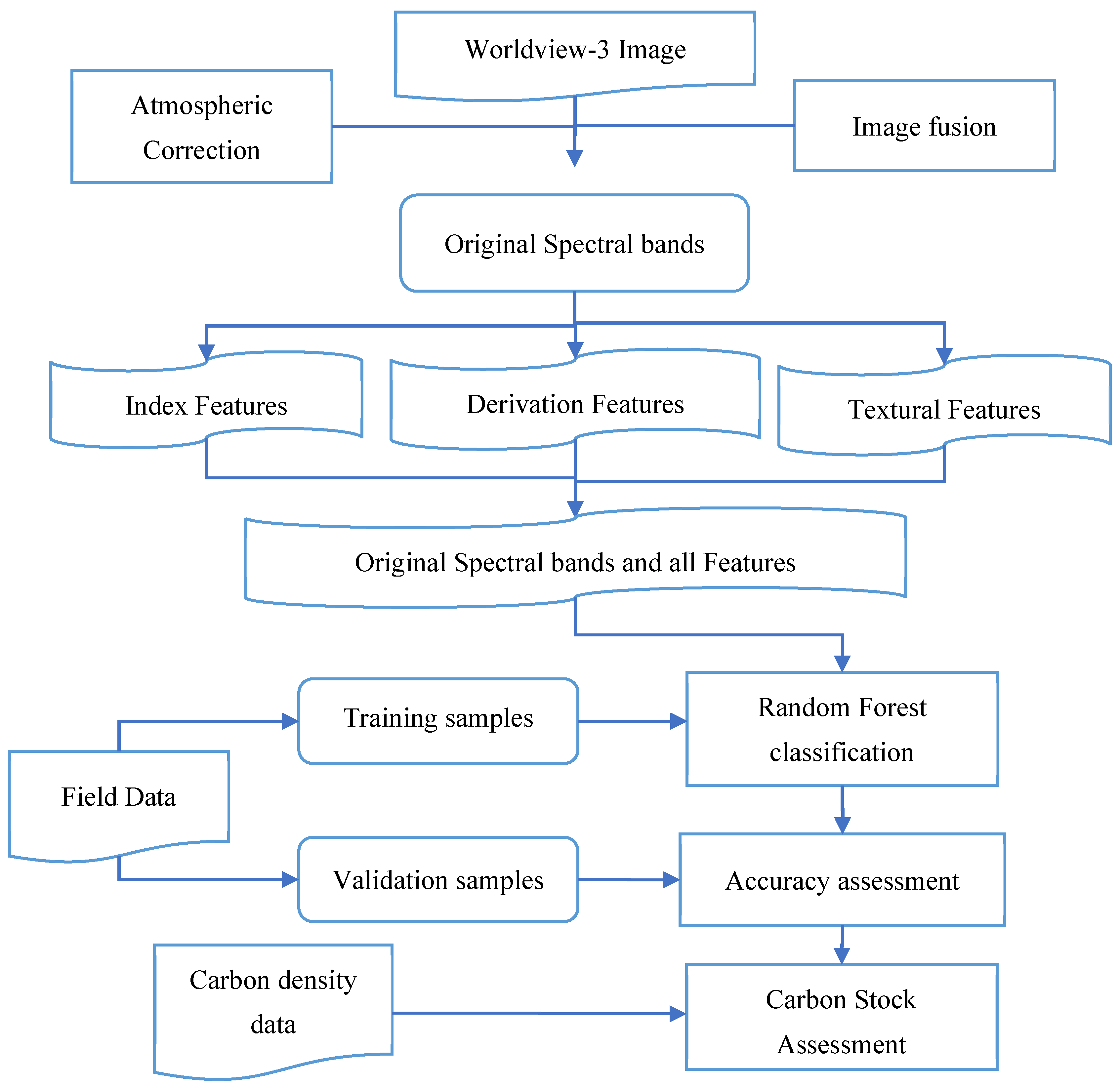
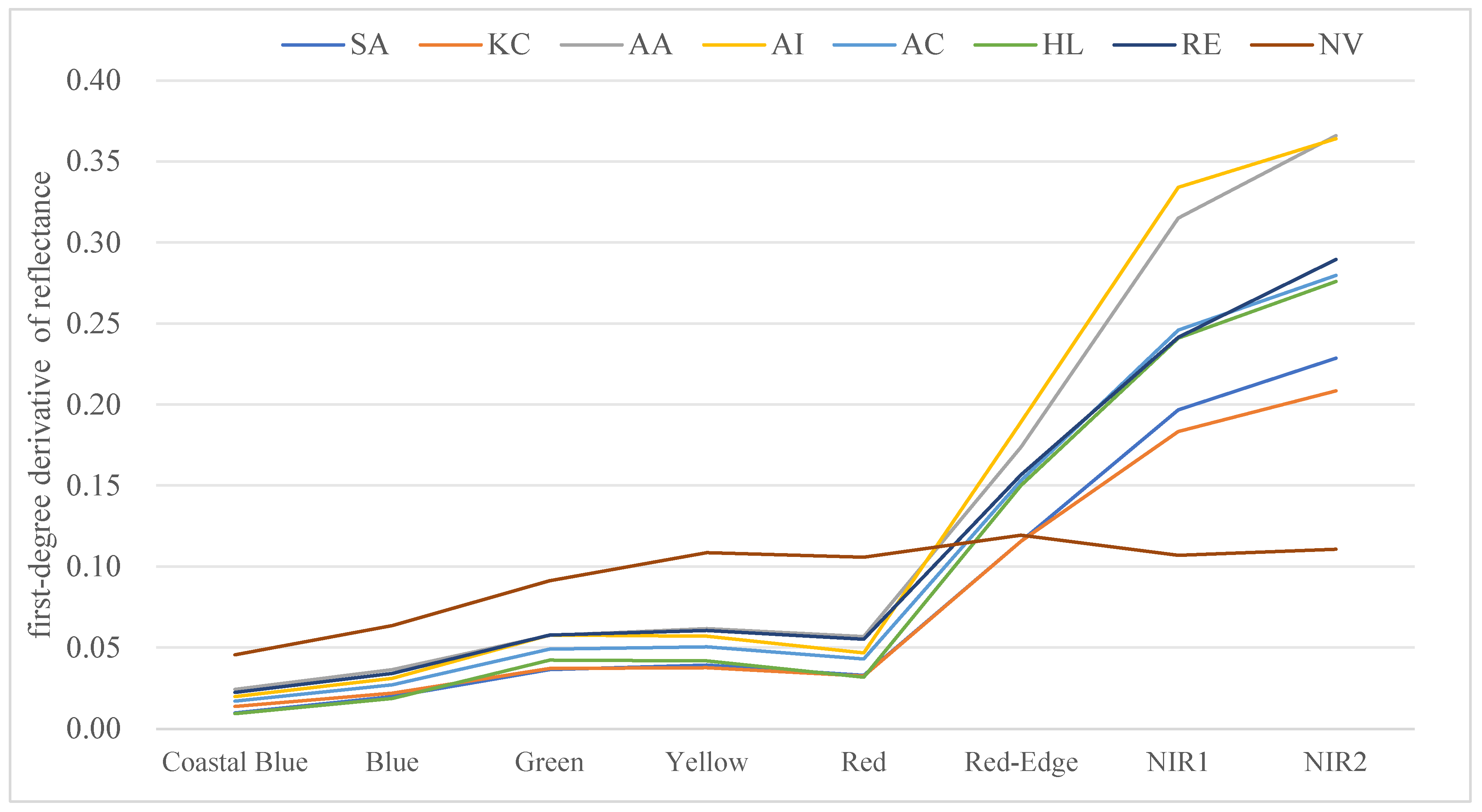
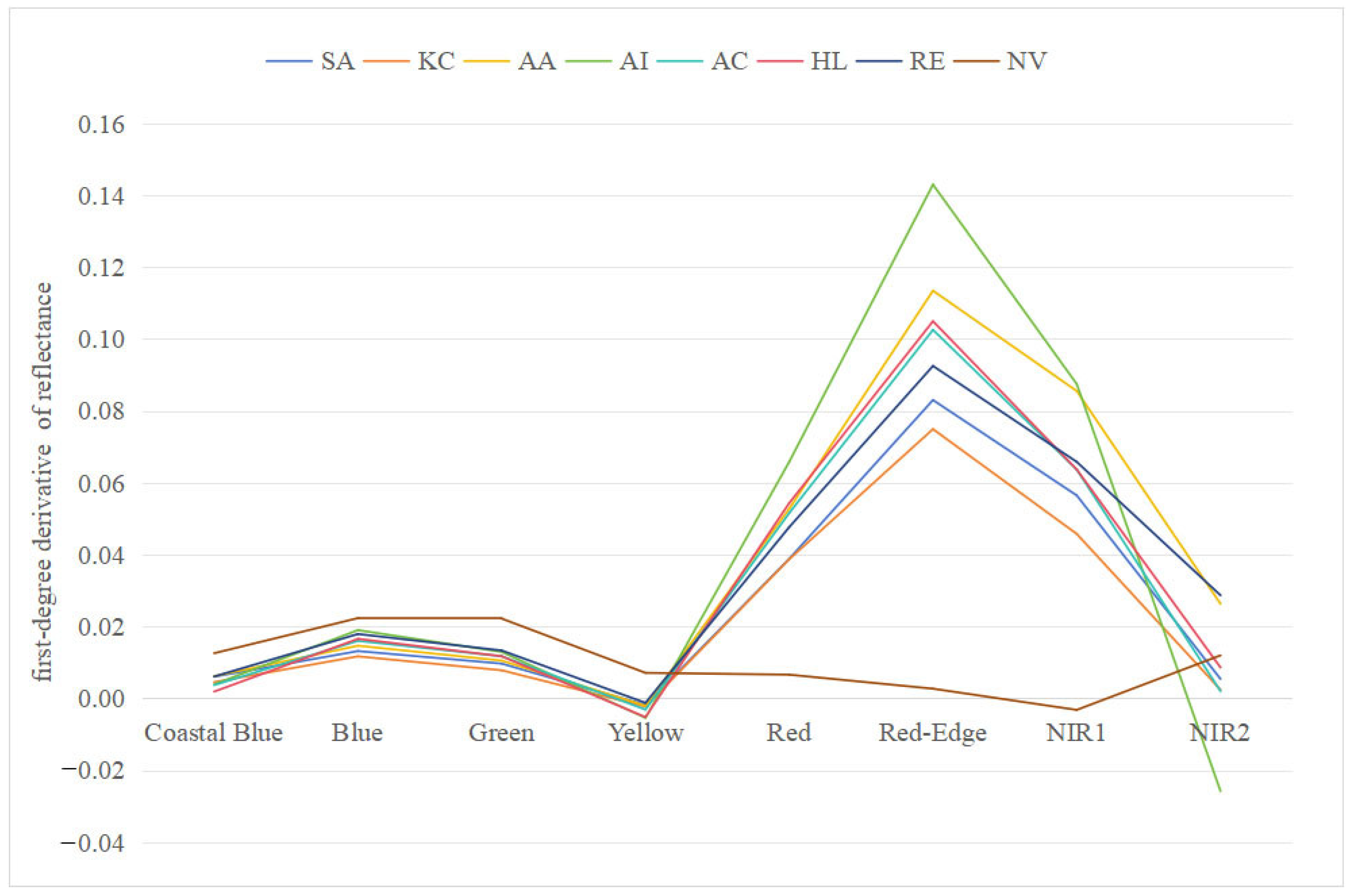
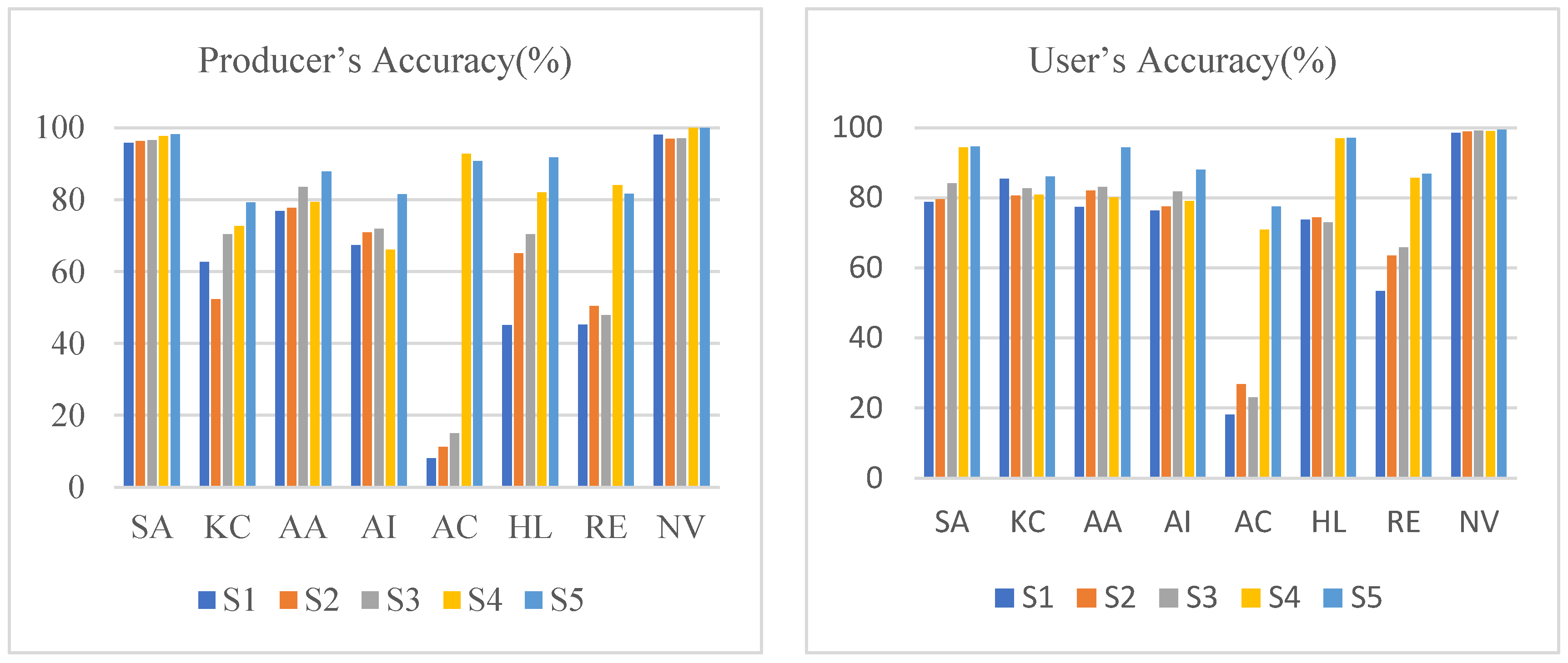

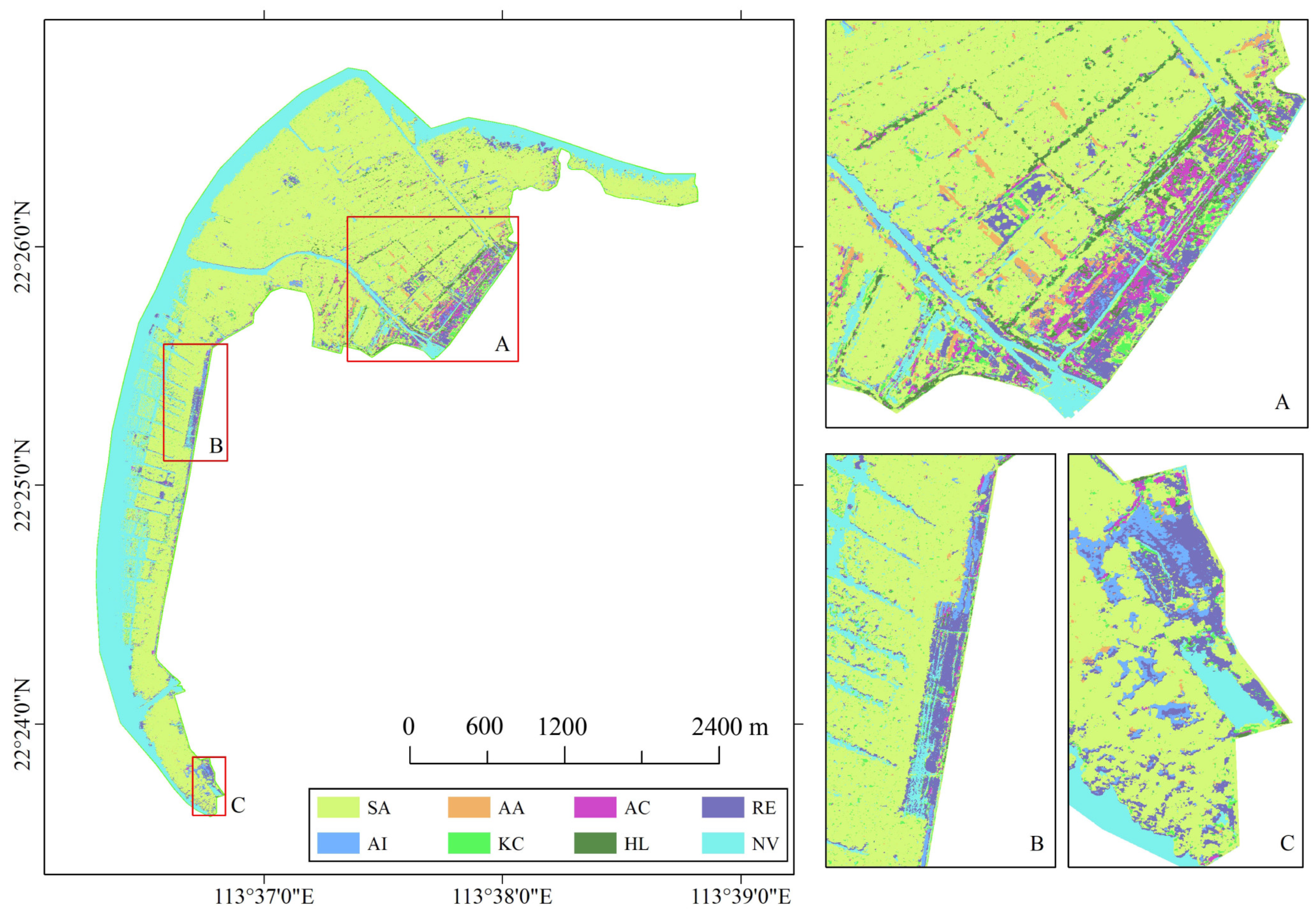
| Species | VCD/(t·ha) | SCD/(t·ha) | LCD/(t·ha) | TCD/(t·ha) |
|---|---|---|---|---|
| SA | 159.99 ± 12.12 | 196.72 ± 9.85 | 1.48 ± 0.13 | 356.92 ± 5.72 |
| KC | 63.50 ± 2.25 | 190.48 ± 8.95 | 0.56 ± 0.07 | 267.35 ± 7.85 |
| AA | 0.79 ± 0.02 | 190.88 ± 7.23 | 0.41 ± 0.02 | 192.08 ± 7.26 |
| AI | 1.13 ± 0.02 | 165.34 ± 8.12 | 0.24 ± 0.03 | 166.72 ± 8.13 |
| AC | 40.49 ± 0.53 | 155.86 ± 9.19 | 0.54 ± 0.04 | 196.91 ± 9.50 |
| HL | 69.40 ± 2.57 | 200.46 ± 5.12 | 1.83 ± 0.15 | 270.60 ± 4.73 |
| SA2 | 1.47 ± 0.00 | 113.55 ± 7.83 | 0.01 ± 0.00 | 115.03 ± 7.83 |
| SA | KC | AA | AI | AC | HL | RE | NV | Total | |
|---|---|---|---|---|---|---|---|---|---|
| Training samples | 55 | 30 | 30 | 30 | 20 | 25 | 35 | 35 | 260 |
| Validation samples | 55 | 30 | 30 | 30 | 20 | 25 | 35 | 35 | 260 |
| Index Features | Formulation | References |
|---|---|---|
| Normalized Difference Water Index | [46] | |
| Normalized Difference Vegetation Index | [47] | |
| Enhanced Vegetation Index | [48] | |
| Difference Vegetation Index | [49] |
| Textural Features | Formulation | References |
|---|---|---|
| Mean | [55] | |
| Variance | [56] | |
| Homogeneity | [50] | |
| Contrast | [50] | |
| Dissimilarity | [55] | |
| Entropy | [50] | |
| Angular Second Moment | [57] | |
| Correlation | [55] |
| Feature Combinations | Number of Bands |
|---|---|
| Original Spectral Values | 7 |
| Original Spectral Values and Index Features | 11 |
| Original Spectral Values and Derivation Features | 14 |
| Original Spectral Values and Textural Features | 15 |
| Original Spectral Values and All Features | 26 |
| Scheme | Input Features | OA | Kappa | Confusion Matrix |
|---|---|---|---|---|
| S1 | Original Spectral Values | 77.20% | 0.6753 | Table S1 |
| S2 | Original Spectral Values and Index Features | 78.81% | 0.6987 | Table S2 |
| S3 | Original Spectral Values and Derivation Features | 81.21% | 0.7373 | Table S3 |
| S4 | Original Spectral Values and Textural Features | 89.53% | 0.8577 | Table S4 |
| S5 | Original Spectral Values and All Features | 92.44% | 0.8972 | Table S5 |
| SA | KC | AA | AI | AC | HL | RE | Total | |
|---|---|---|---|---|---|---|---|---|
| Area/ha | 393.90 | 16.58 | 5.58 | 7.90 | 1.04 | 8.06 | 18.80 | 451.86 |
| Area ratio/% | 87.17 | 3.67 | 1.24 | 1.75 | 0.23 | 1.78 | 4.16 | 100% |
| Average TCD/(t·ha) | 356.92 ± 5.72 | 267.35 ± 7.85 | 192.08 ± 7.26 | 166.72 ± 8.13 | 196.91 ± 9.50 | 270.6 ± 4.73 | 115.03 ± 7.83 | / |
| Carbon stock/t | 140,590.79 ± 2041.58 | 4432.66 ± 2098.70 | 1071.81 ± 1394.50 | 1317.09 ± 1355.43 | 204.79 ± 1870.65 | 2181.04 ± 1279.94 | 2162.56 ± 900.68 | 151,960.73 ± 4182.34 |
| Carbon ratio/% | 92.52 | 2.92 | 0.71 | 0.87 | 0.14 | 1.43 | 1.42 | 100 |
Disclaimer/Publisher’s Note: The statements, opinions and data contained in all publications are solely those of the individual author(s) and contributor(s) and not of MDPI and/or the editor(s). MDPI and/or the editor(s) disclaim responsibility for any injury to people or property resulting from any ideas, methods, instructions or products referred to in the content. |
© 2023 by the authors. Licensee MDPI, Basel, Switzerland. This article is an open access article distributed under the terms and conditions of the Creative Commons Attribution (CC BY) license (https://creativecommons.org/licenses/by/4.0/).
Share and Cite
Sun, Y.; Ye, M.; Jian, Z.; Ai, B.; Zhao, J.; Chen, Q. Species Classification and Carbon Stock Assessment of Mangroves in Qi’ao Island with Worldview-3 Imagery. Forests 2023, 14, 2356. https://doi.org/10.3390/f14122356
Sun Y, Ye M, Jian Z, Ai B, Zhao J, Chen Q. Species Classification and Carbon Stock Assessment of Mangroves in Qi’ao Island with Worldview-3 Imagery. Forests. 2023; 14(12):2356. https://doi.org/10.3390/f14122356
Chicago/Turabian StyleSun, Yuchao, Mingzhen Ye, Zhuokai Jian, Bin Ai, Jun Zhao, and Qidong Chen. 2023. "Species Classification and Carbon Stock Assessment of Mangroves in Qi’ao Island with Worldview-3 Imagery" Forests 14, no. 12: 2356. https://doi.org/10.3390/f14122356
APA StyleSun, Y., Ye, M., Jian, Z., Ai, B., Zhao, J., & Chen, Q. (2023). Species Classification and Carbon Stock Assessment of Mangroves in Qi’ao Island with Worldview-3 Imagery. Forests, 14(12), 2356. https://doi.org/10.3390/f14122356







